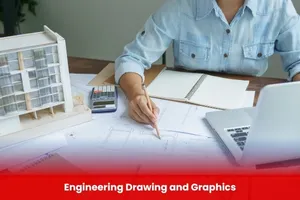Engineering Drawing and Graphics
At BURAAQ UK, we recognize the critical role that Engineering Drawing and Graphics play in bridging the gap between design concepts and physical realization. This foundational discipline enables engineers, designers, and technicians to communicate technical information clearly, precisely, and universally.Our Engineering Drawing & Graphics training is designed to equip learners with the skills to create, interpret, and analyze technical drawings using both traditional manual drafting techniques and modern computer-aided design (CAD) software.

Aim of Engineering Drawing and Graphics
The aim of the Engineering Drawing & Graphics course at BURAAQ UK is to develop learners’ skills in creating, interpreting, and communicating precise technical drawings using both manual drafting and computer-aided design (CAD) techniques, enabling accurate visualization and documentation essential for engineering and manufacturing processes.
Course Overview
Engineering Drawing and Graphics
Educational Background
- Minimum qualification: Secondary education (GCSE, Matriculation, or equivalent)
- Preferred qualification:
- Diploma or Degree in Engineering or related technical fields
- Students currently enrolled in engineering or technical program
Skills and Knowledge
- Basic understanding of mathematics and geometry
- Familiarity with technical concepts in engineering (preferred but not mandatory)
- Basic computer skills, especially for CAD-based modules
Suitable For
- Engineering students at diploma or undergraduate levels
- Technicians and apprentices aiming to strengthen drafting and design skills
- Professionals in manufacturing, construction, or engineering fields seeking refresher or upskilling
- CAD beginners who want to develop foundational skills in engineering graphics
| Course Code | Curriculum Title | Credit | DLH |
|---|---|---|---|
| BUK1387-1 | Introduction to Engineering Drawing | 3 | 10 |
| BUK1387-2 | Basic Drawing Techniques | 3 | 10 |
| BUK1387-3 | Orthographic Projections | 3 | 10 |
| BUK1387-4 | Sectional Views and Cutting Planes | 3 | 10 |
| BUK1387-5 | Isometric and Pictorial Drawing | 3 | 10 |
| BUK1387-6 | Dimensioning and Tolerancing | 3 | 10 |
Module 1: Introduction to Engineering Drawing
- Importance and applications of engineering drawing
- Types of drawings: orthographic, isometric, sectional, and pictorial
- Drawing instruments and materials
Module 2: Basic Drawing Techniques
- Lines, lettering, and dimensioning
- Geometrical constructions (angles, polygons, circles)
- Scales and scale drawing
Module 3: Orthographic Projections
- Principles of orthographic projection
- First and third angle projection methods
- Drawing views: front, top, side
Module 4: Sectional Views and Cutting Planes
- Purpose of sectional views
- Types of sections: full, half, offset, removed
- Representing hidden details and internal features
Module 5: Isometric and Pictorial Drawing
- Isometric projection principles
- Drawing isometric views from orthographic drawings
- Types of pictorial drawings: oblique, perspective
Module 6: Dimensioning and Tolerancing
- Types of dimensions and their placement
- Tolerances and fits basics
- Standards for dimensioning (ISO, BS)
Module 7: Introduction to Computer-Aided Design (CAD)
- Overview of CAD software (AutoCAD basics)
- Drawing setup and tools in CAD
- Creating, editing, and printing technical drawings
Module 8: Engineering Drawing Standards and Conventions
- International drawing standards (ISO, BS, ASME)
- Symbols, abbreviations, and notation
- Title blocks, revision notes, and drawing documentation
Module 9: Practical Assignments and Project Work
- Hands-on drawing exercises (manual and CAD)
- Interpretation of engineering drawings
- Final project: Create a complete set of engineering drawings
- Diploma or undergraduate students in:
- Technicians and Apprentices
- Professionals and Career Switchers
- Beginners in CAD or Drafting
- All Modules within this qualification are assessed internally by the approved training Centre and externally verified by BURRAQ UK. The program uses a criterion-referenced assessment approach to ensure that learners successfully meet all required learning outcomes.
- A Pass in any unit is granted only when the learner submits valid, reliable, and authentic evidence that demonstrates achievement of the assessment criteria. The Assessor is responsible for reviewing this evidence and confirming that the learner has attained the expected standard.
